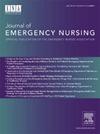病例报告:急诊科躁动的阿尔茨海默病患者的护理
IF 2.3
4区 医学
Q2 EMERGENCY MEDICINE
引用次数: 0
摘要
据估计,全球处于阿尔茨海默病(痴呆症的一种形式)不同阶段的人数为4.16亿人。据估计,50岁以上的人中有22%患有阿尔茨海默病。根据美国国家老龄化研究所的数据,数百万家庭在家照顾患有严重慢性疾病的亲人,其中包括阿尔茨海默病。急诊护士了解这些统计数据是很重要的,因为他们分配的急诊病人可能处于阿尔茨海默病的任何阶段。这个病例报告是关于一个患有晚期阿尔茨海默病的病人在家里由她的女儿照顾,她的女儿是一位经验丰富的急救护士。患者因阿尔茨海默病痴呆而出现无法控制的躁动,需要多次急诊。发现急诊护士对可用资源的了解存在差距,以帮助家庭成员对患有阿尔茨海默病的亲人进行家庭护理。提供了一些工具,使急诊护士能够在护理患有无法控制的阿尔茨海默病躁动的患者期间进行护理。姑息和临终关怀服务提供给亲人与阿尔茨海默病进行了讨论。鼓励急诊护士与家属分享信息,以促进在亲人生命结束时的尊严。本文章由计算机程序翻译,如有差异,请以英文原文为准。
Case Report: Care of the Agitated Emergency Department Patient With Alzheimer’s Disease
Global estimates of persons in various stages of Alzheimer’s disease, a form of dementia, were estimated to be at 416 million. It is estimated that 22% of people who are 50 years of age or older have Alzheimer’s disease. According to the National Institute on Aging, millions of families took care of loved ones at home who had serious chronic diseases, which included Alzheimer’s disease. It is important that these statistics are understood by emergency nurses because their assigned emergency patient may be in any stage of Alzheimer’s disease.
This case report is about a patient with advanced Alzheimer’s disease being cared for at home by her daughter, an experienced emergency nurse. The patient developed uncontrollable agitation owing to Alzheimer’s disease dementia that necessitated multiple emergency department visits. A gap in emergency nurses’ knowledge of available resources to help family members navigate home care of loved ones with Alzheimer’s disease was identified.
Tools that empower emergency nurses during care of patients with uncontrolled Alzheimer’s disease agitation are provided. Palliative and hospice services available for loved ones with Alzheimer’s disease are discussed. Emergency nurses are encouraged to share information with families to facilitate dignity during a loved one’s end of life.
求助全文
通过发布文献求助,成功后即可免费获取论文全文。
去求助
来源期刊
CiteScore
3.10
自引率
11.80%
发文量
132
审稿时长
46 days
期刊介绍:
The Journal of Emergency Nursing, the official journal of the Emergency Nurses Association (ENA), is committed to the dissemination of high quality, peer-reviewed manuscripts relevant to all areas of emergency nursing practice across the lifespan. Journal content includes clinical topics, integrative or systematic literature reviews, research, and practice improvement initiatives that provide emergency nurses globally with implications for translation of new knowledge into practice.
The Journal also includes focused sections such as case studies, pharmacology/toxicology, injury prevention, trauma, triage, quality and safety, pediatrics and geriatrics.
The Journal aims to mirror the goal of ENA to promote: community, governance and leadership, knowledge, quality and safety, and advocacy.

 求助内容:
求助内容: 应助结果提醒方式:
应助结果提醒方式:


